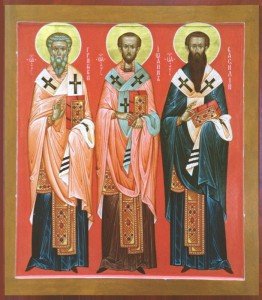 In the last issue of this article I began sharing what the Cappadocian Fathers taught, especially about the Holy Spirit. The fact that man’s life is somehow connected with God’s breath, makes man to be God’s image. A being taken from the earth, writes Father Cyril of Alexandria, could not be seen as an image of the Most High, if he had not received this breath. Thus the perfecting action of the Spirit does not belong to the category of the miraculous, but forms a part of the original and natural plan of God. It should be remembered that in Genesis God first takes earth and forms man and then breathes into that which He formed from the earth.
In the last issue of this article I began sharing what the Cappadocian Fathers taught, especially about the Holy Spirit. The fact that man’s life is somehow connected with God’s breath, makes man to be God’s image. A being taken from the earth, writes Father Cyril of Alexandria, could not be seen as an image of the Most High, if he had not received this breath. Thus the perfecting action of the Spirit does not belong to the category of the miraculous, but forms a part of the original and natural plan of God. It should be remembered that in Genesis God first takes earth and forms man and then breathes into that which He formed from the earth.
God’s Spirit assumes, inspires and vivifies everything which is still fundamentally good and beautiful and maintains in creation the first fruits of the eschatological transfiguration – that is the Spirit maintains the potential in humankind that changes when humans undertake cooperating with God and bringing about the actualization of this potential. In this sense, the Spirit is the very content of the Kingdom of God. Gregory of Nyssa reports the ancient variant for the text of the Lord’s prayer, “Thy Kingdom come,” in Luke 11;2, as:” May Thy Holy Spirit come upon us and cleanse us.” The Byzantine liturgical tradition maintains the same tradition when it starts every single office with an eschatological invocation of the Spirit, addressing Him as “Heavenly King.” We also see in the Divine Liturgy that it is only after the Holy Spirit is invoked that the bread and wine become the Body and Blood of Christ – that the symbols of life are really transformed into the very Body and Blood of our Incarnate God.
The liturgical office of Pentecost, centered mainly on the role of the Spirit in redemption and salvation, also glorifies the Spirit as “the One Who rules all things, Who is Lord of all, and Who preserves creation from falling apart.” Our Greek Catholic customs associated with the feast of Pentecost suggest that the outpouring of the Spirit is indeed an anticipation of cosmic transfiguration. The traditional decoration of churches with greens and flowers on that day reflects the experience of new creation. This is one reason why we wear green vestments on Pentecost instead of red vestments as the Western Church does. Since our Church was developed in an agrarian society, the color green always represented the newness of life springing forth from dormant plants.
